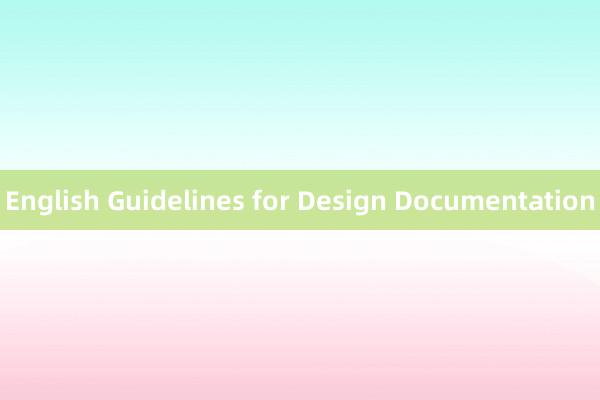
### English Guidelines for Design Documentation: Crafting Clear and Effective Technical Descriptions
Design documentation serves as the backbone of any project, providing a comprehensive guide for developers, stakeholders, and future maintainers. When it comes to creating English design documentation, clarity, precision, and consistency are paramount. Here are key guidelines to help you craft clear and effective technical descriptions:
#### 1. **Purpose and Audience**
- **Purpose**: Define the purpose of your documentation. Is it for initial design approval, implementation guidance, or maintenance reference? Understanding the purpose helps tailor the content appropriately.
- **Audience**: Identify who will read the documentation (developers, project managers,个人笔记 stakeholders). This influences the level of detail and technical jargon used.
#### 2. **Structure and Organization**
- **Logical Flow**: Organize the document in a logical flow that aligns with how users navigate the information. Typically, 琳咖摄影 this includes an introduction, main sections detailing each component or feature, and conclusions or appendices.
- **Headings and Subheadings**: Use headings and subheadings to break down complex information into manageable sections. This aids quick reference and understanding.
#### 3. **Language and Style**
- **Clarity and Precision**: Write in clear,海口曼洁霆服装有限责任公司 concise sentences. Avoid ambiguity and use precise language to describe functionalities and constraints.
- **Consistent Terminology**: Use consistent terminology throughout the document. Define any technical terms that might not be universally understood by all readers.
- **Active Voice**: Prefer active voice over passive voice to make the text more engaging and direct.
#### 4. **Use of Examples and Diagrams**
心向众创公司- **Examples**: Include examples to illustrate concepts, especially if they are complex or abstract. This makes the documentation more relatable and easier to understand.
- **Diagrams and Screenshots**: Visual aids such as diagrams, flowcharts, and screenshots can significantly enhance comprehension. Ensure these are high quality and directly relevant to the content.
#### 5. **Version Control and Updates**
- **Versioning**: Clearly indicate the version of the document and its date. This helps users track changes and updates easily.
- **Revision History**: Maintain a record of changes made to the document. This transparency is crucial for accountability and maintaining the integrity of the documentation.
#### 6. **Accessibility and Formatting**
- **Accessibility**: Ensure the documentation is accessible to people with disabilities. This might include using alt text for images, ensuring readable fonts, and maintaining a logical structure.
- **Formatting**: Use standard formatting practices like bullet points, numbered lists, and bold or italic text for emphasis. This enhances readability and comprehension.
#### 7. **Review and Feedback**
- **Peer Review**: Have peers review the documentation for clarity, accuracy, and completeness. Fresh eyes can often spot issues that the author might have overlooked.
- **Feedback Mechanism**: Provide a mechanism for users to give feedback on the documentation. This can help identify areas that need improvement and ensure ongoing relevance.
By adhering to these guidelines, you can create English design documentation that not only meets the needs of your project but also serves as a valuable resource for years to come. Remember海口曼洁霆服装有限责任公司, the goal is to facilitate understanding, reduce errors, and streamline processes across your team and beyond.
